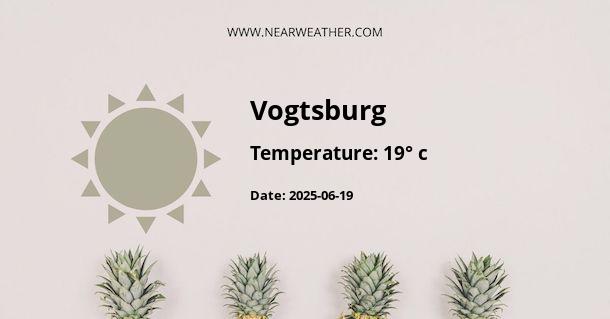Understanding the Climate and Weather in Vogtsburg, Germany
Located in the heart of the Kaiserstuhl region, Vogtsburg is the largest wine municipality in Baden-Württemberg, Germany. Renowned for its picturesque landscapes and mild climate, it presents an excellent case study of the weather patterns typical to this part of Central Europe. In this comprehensive guide, we will delve into the climatic conditions of Vogtsburg, examining temperature trends, precipitation patterns, and season-specific weather phenomena.
Geographical Influence on Vogtsburg's Climate
The Kaiserstuhl region, where Vogtsburg is situated, is heavily influenced by its geographical location and topography. Nestled in the Upper Rhine Plain, the area is known for its volcanic hills that contribute to a unique microclimate. It is one of the warmest regions in Germany, enabling viticulture and a variety of fruits to thrive. To understand Vogtsburg's climate, it is essential to consider the following geographical factors:
- Proximity to the Rhine River
- Slightly elevated position in the Rhine Plain
- Sheltered valley locations
- Volcanic soil composition
General Climate Classification
Vogtsburg experiences an oceanic climate (Köppen climate classification Cfb), with relatively mild summers, cool winters, and precipitation distributed throughout the year. Its climate can also exhibit some characteristics of a continental climate due to its location away from the immediate influence of the Atlantic Ocean.
Temperature Variability and Averages
One of the key aspects of Vogtsburg's climate is its temperature range. On average, the temperatures in Vogtsburg fluctuate between the coldest month, January, with average lows of around -1°C (30°F), and the warmest month, July, with average highs of approximately 25°C (77°F). Moreover, the Kaiserstuhl region is known for having some of the highest recorded temperatures in Germany during heatwaves.
According to a long-term study by the German Weather Service (Deutscher Wetterdienst), the average annual temperature in Vogtsburg has been gradually increasing, which experts attribute to climate change.
Monthly Weather Patterns and Precipitation
Here we'll derive a detailed analysis of Vogtsburg's monthly weather patterns and precipitation throughout the year:
| Month | Average High (°C) | Average Low (°C) | Precipitation (mm) |
|---|---|---|---|
| January | 4 | -1 | 46 |
| February | 7 | 0 | 43 |
| March | 12 | 2 | 55 |
| April | 16 | 5 | 53 |
| May | 21 | 9 | 99 |
| June | 24 | 13 | 96 |
| July | 25 | 14 | 90 |
| August | 25 | 14 | 77 |
| September | 21 | 11 | 65 |
| October | 15 | 7 | 66 |
| November | 9 | 3 | 63 |
| December | 5 | 0 | 58 |
This table indicates that May and June are the wettest months, while the period from February to April tends to be drier. This distribution of precipitation plays an essential role in the local agriculture, particularly the timing of grapevine growth and fruit set.
Seasonal Weather Conditions
Spring
Spring in Vogtsburg typically begins with cool temperatures and gradually warming conditions. This is the crucial budding season for the vines. Occasional late frosts can be of concern, and local vintners often deploy frost protection methods.
Summer
In summer, Vogtsburg often enjoys warm and sunny days, with pleasant temperatures that are perfect for outdoor activities. Although heatwaves can occur, the region benefits from the cooling breezes coming off the Rhine River, mitigating extreme heat.
Autumn
Autumn is a particularly beautiful season in Vogtsburg due to the changing vineyard foliage. It is also the harvest period for grapes. Weather conditions can vary significantly, from warm Indian summer days to chilly and foggy mornings typical for late October and November.
Winter
Winters are relatively mild compared to more northern or elevated regions of Germany. Snowfall can occur, but it is usually not persistent. Vogtsburg's proximity to the Rhine River often means that it is shrouded in fog during the winter months.
Extreme Weather Events and Climate Change
While extreme weather is relatively rare in Vogtsburg, the region is not immune to the effects of climate change. Heatwaves and severe thunderstorms have become more frequent. The DWD records indicate trends in warmer winter months, earlier onset of spring, and hotter summers.
Weather Forecasting Tools and Local Observations
For accurate and current weather forecasts in Vogtsburg, the German Weather Service provides detailed meteorological data, which can be accessed online or through various mobile apps. Additionally, local vintners and farmers often share valuable first-hand observations of the weather patterns, particularly as they relate to the viticulture that defines the region.
Conclusion
In summary, Vogtsburg's climate boasts a blend of mild, sunny intervals and sufficient rainfall that supports its esteemed wine culture. With the backdrop of climate change influencing weather patterns worldwide, it is imperative that residents and visitors to Vogtsburg stay informed about local weather forecasts and long-term climate projections. This knowledge not only allows for better planning and preparation but also contributes to understanding and preserving the unique environmental conditions that make Vogtsburg so special.
Understanding the intricate details of Vogtsburg's climate requires acknowledgment of both its geographical nuances and broader meteorological trends. Whether for agricultural planning, tourism, or simply day-to-day weather readiness, comprehending Vogtsburg's weather patterns is critical in adapting to and appreciating the region's natural beauty and climate throughout the year.
A - Vogtsburg's Latitude is 48.083328 & Longitude is 7.683330.
A - Weather in Vogtsburg is 1° today.
A - Climate Conditions in Vogtsburg shows scattered clouds today.
A - Humidity in Vogtsburg is 85% today.
A - Wind speed in Vogtsburg is 5.47 km/h, flowing at 14° wind direction. today.
